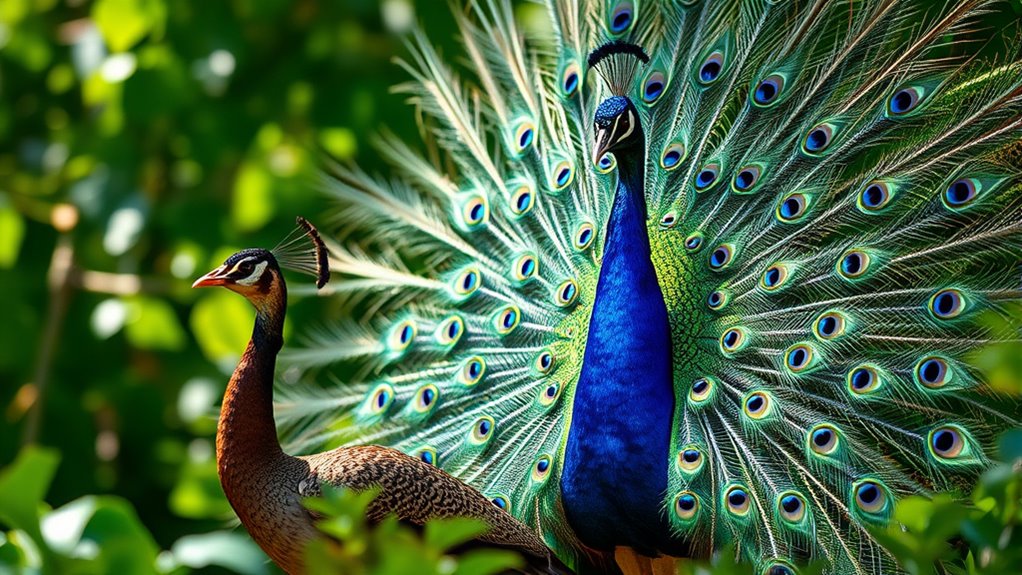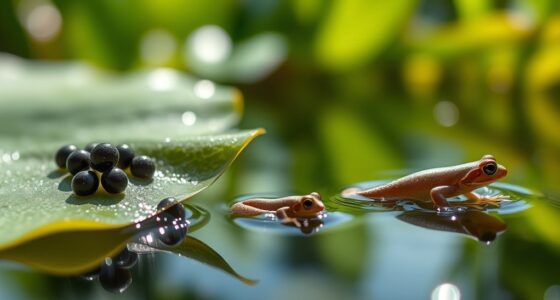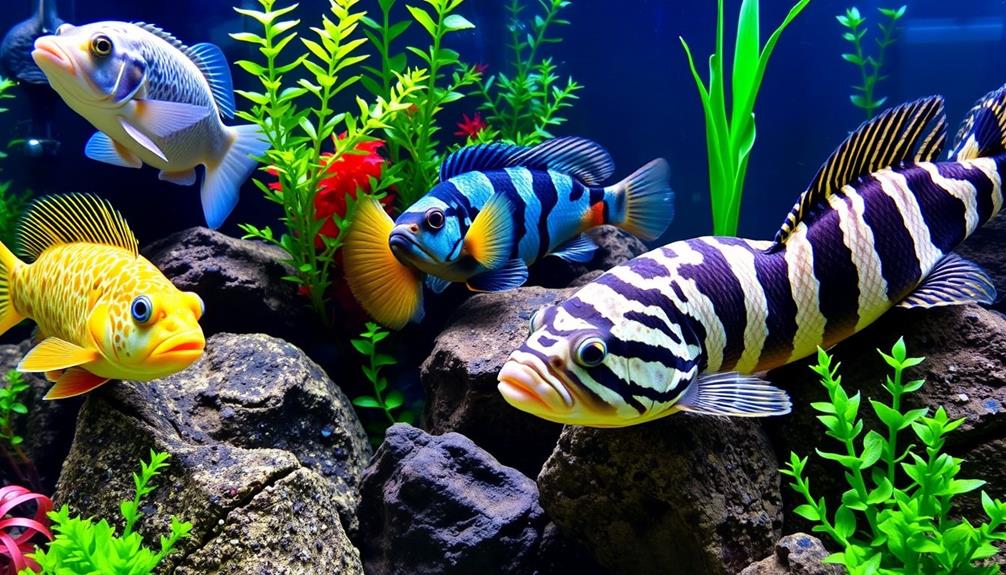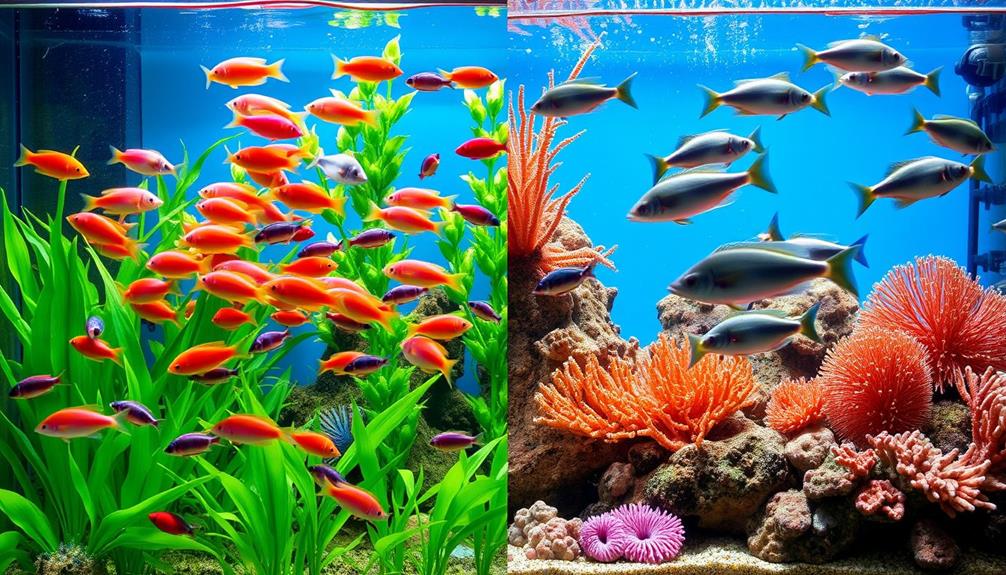Color plays an essential role in animal mating by signaling health and genetic quality. Bright hues attract mates and indicate fitness, enhancing reproductive success. Many species rely on vibrant colors, which are often linked to proper physiological processes. Environmental factors and habitat also shape these displays, influencing how animals communicate their suitability as partners. As you explore further, you'll uncover fascinating details about how these colorful traits evolve and the mechanisms behind them.
Key Takeaways
- Bright colors in animals signal health and genetic quality, enhancing mating success and attracting potential partners.
- Color displays are resource-intensive, indicating male strength and territory ownership during courtship.
- Structural and pigment-based coloration mechanisms influence color vibrancy, affecting mate attraction strategies across different environments.
- Visual cues, including color perception, play a critical role in mate selection, helping prevent interspecies mating.
- Sexual dichromatism showcases distinct color differences between genders, with vibrant male colors signaling fitness to attract females.
The Importance of Color in Courtship Displays

When it comes to animal courtship, color plays a critical role in attracting mates. Birds of paradise, for example, showcase unique feather structures that create stunning iridescent effects, enhancing their visual displays during courtship dances. Sunlight dramatically influences how these colors appear, making the timing of their displays vital. Interestingly, the male Lawes parotia bird's feathers possess multi-layered reflective properties, which allow for dramatic color changes that are crucial during courtship.
Hummingbirds utilize shuttle displays to highlight their vibrant colors, effectively capturing the attention of potential mates. The structural coloration found in their feathers reflects light in remarkable ways, amplifying their appeal.
Additionally, animals adapt their displays to environmental conditions, ensuring they maximize visibility. Ultimately, the perception of colors by potential mates defines the success of these intricate courtship rituals, making color an essential element in the mating game.
Evolutionary Significance of Color in Mating
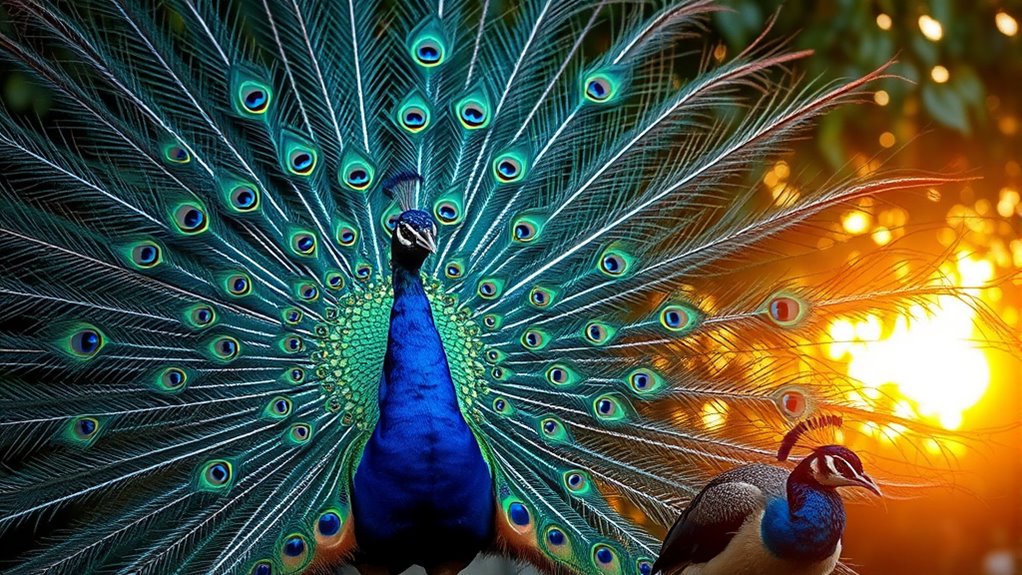
Color plays a vital role in sexual selection, where brighter hues often signal health and genetic quality to potential mates. When you observe these vivid displays in the animal kingdom, you're witnessing an evolutionary strategy that enhances reproductive success. Understanding the significance of color can shed light on how species adapt and thrive in their environments. Additionally, the ancestors of these brightly colored mating species were primarily diurnal animals, which influenced the evolution of vibrant colors for attraction.
Sexual Selection Mechanisms
While many traits evolve primarily for survival, sexual selection mechanisms highlight the importance of color in mating strategies. In this process, certain traits, like vivid colors, evolve to enhance mating success rather than just survival. You'll notice that mate choice and competition among individuals of the same sex play key roles. Bright colors can signal a male's fitness, attracting female partners and helping species identify potential mates. Additionally, males often use their colors in competition, with brighter hues indicating strength or territorial ownership. The evolutionary impact of these mechanisms drives the development of conspicuous traits, demonstrating how color can greatly influence mating opportunities, even when it mightn't boost survival directly. Sexual selection can also lead to increased visibility to predators, highlighting the trade-offs involved in developing such striking features.
Color as Health Indicator
Bright hues in the animal kingdom often serve as crucial indicators of health and vitality, influencing mate selection considerably. When you observe vibrant colors in animals, think of those hues as signals of their overall well-being. Maintaining bright colors can drain resources, making them costly to produce. These displays are linked to physiological processes that guarantee honesty in health signaling. Curiously, bright colors can also warn predators of toxicity, adding another layer of survival strategy. Male color displays are often critical in attracting potential mates, emphasizing the importance of vibrant colors in the competitive mating landscape.
Female animals tend to favor males with more intense colors, interpreting this as a sign of superior health. However, the effectiveness of these signals can shift based on ecological contexts, like light availability, influencing how color plays a role in mating success.
Genetic Quality Signaling
In the intricate world of animal mating, the hues displayed by individuals often serve as essential indicators of genetic quality. These color patterns can signal a mate's fitness, influencing selection processes.
Here are some key aspects of genetic quality signaling through color:
- Genetic Architecture: Color polymorphisms cluster with other traits, enhancing their significance.
- Mate Preferences: Color traits are linked to mate preferences, shaping reproductive choices. Additionally, female preference in species like Oophaga pumilio demonstrates how color can influence mate selection.
- Honesty Mechanisms: Costly signaling guarantees that vibrant colors reflect true quality, maintaining reliability.
- Species Divergence: Unique color patterns can act as prezygotic barriers, promoting species differentiation.
Understanding how color reflects genetic quality helps you appreciate the complex dynamics of animal mating strategies and evolutionary processes.
Mechanisms Behind Color Production in Animals
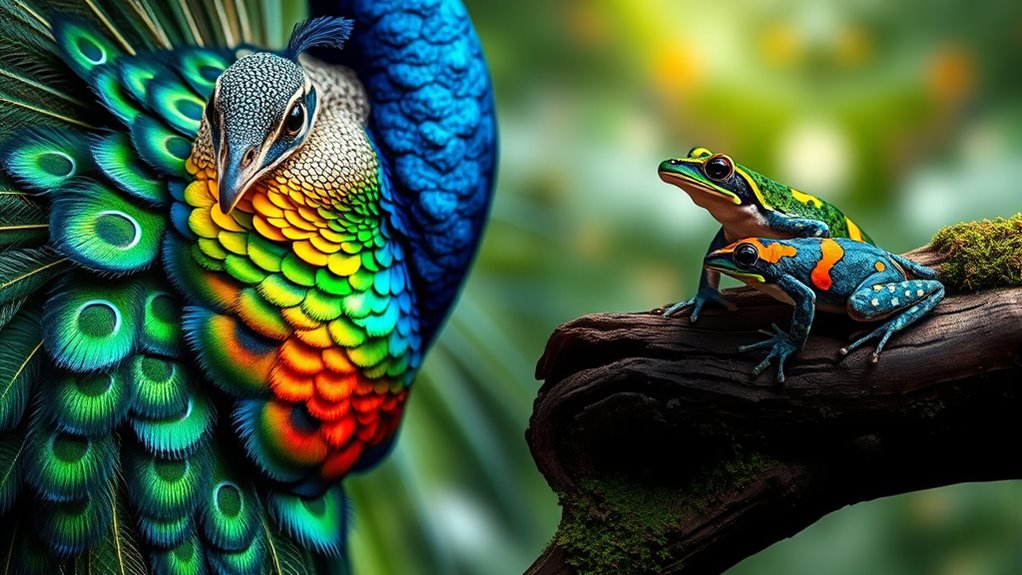
Color production in animals involves intricate mechanisms that reflect both biological processes and environmental influences.
You'll find two main types: pigment-based and structural coloration. Pigment-based colors arise from pigments like melanin, which absorbs light, and carotenoids, often acquired through diet. The interaction between structural and pigmentary colors adds complexity to the color variations seen in different species.
Structural coloration, on the other hand, is created by nano-scale structures that scatter light, giving rise to vibrant hues like blue and iridescence.
Specialized cells called chromatophores allow animals like cephalopods to change colors rapidly by repositioning stored pigments.
Genetic factors play a vital role, controlling pigment production and influencing overall color patterns.
Environmental conditions, such as temperature and pH, can also impact how colors are produced, showcasing the dynamic interplay between biology and surroundings.
Color as a Key Factor in Mate Choice

When it comes to mate choice, color plays a vital role in attraction and selection. You'll often notice that vibrancy and contrast can signal health and genetic quality, making individuals more appealing. Ensuring JavaScript is enabled can also enhance the ability of animals to perceive these color signals effectively. Understanding these visual cues can help you appreciate the intricate strategies animals use in their mating behaviors.
Vibrancy and Attraction
Brightly colored animals often capture your attention, showcasing how vibrancy plays an essential role in mate attraction. For many species, these vivid hues serve as critical signals in sexual selection, enhancing their visual appeal.
Here are a few key aspects of vibrancy in mate choice:
- Bright colors like red, orange, and yellow signal health and fitness.
- Diurnal species benefit from their colors being more visible during the day, increasing attraction. This advantage is particularly evident in species whose ancestors were linked to sexual signaling.
- Blue coloration often indicates mating readiness, rather than predator avoidance.
- Consistent color patterns across species strengthen mating signals, promoting compatibility.
Visual Cues Importance
In the world of animal mating, visual cues play a pivotal role in how individuals assess potential partners. Color preferences can greatly influence mate selection, allowing animals to evaluate potential mates from a distance and enhancing species recognition. This multi-cue approach helps prevent costly matings with other species. Recent studies suggest that chemical signals may also significantly impact female mate choice in butterflies, indicating that visual cues alone may not determine mating success.
| Species | Color Preference |
|---|---|
| Blue Crabs | Females with red claw dactyls |
| Butterflies | Wing patterns and colors |
| Sticklebacks | Visual cues in clear water |
Environmental factors also impact these visual cues, as light conditions and predation risks can alter which cues are prioritized. Understanding these dynamics reveals the complexity of mate choice in the animal kingdom.
Color Signals Health
Color plays an essential role in signaling health during mate choice, as vibrant hues often indicate an individual's vigor and genetic fitness.
When you observe bright colors, you're likely witnessing important signals about a potential mate's quality. Here are key points to reflect on:
- Color Intensity: Brighter colors suggest better health and fitness.
- Diet Influence: A diet rich in carotenoids enhances color, signaling strong health.
- Territorial Defense: Males with vivid hues can defend their territory effectively, making them attractive.
- Energy Investment: The effort to maintain bright colors shows a male's overall vitality, indicating that bright coloration serves as a survival mechanism during predator encounters.
These visual cues help you make informed choices, ensuring the best genes are passed on to future generations.
Comparative Analysis of Color Displays Across Species
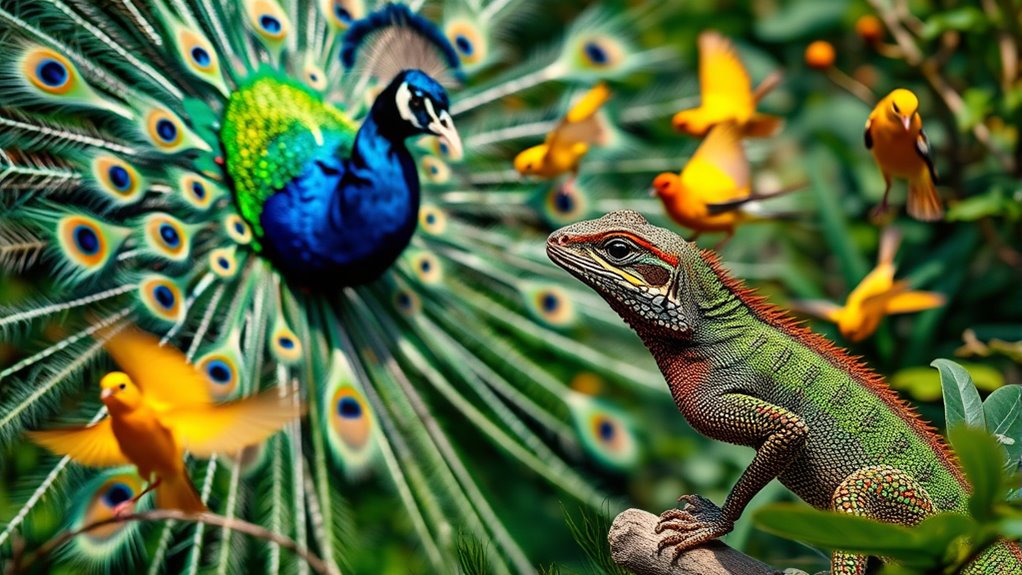
While exploring the diverse world of animal mating displays, it's fascinating to see how various species have evolved unique color patterns that serve specific purposes.
In more vegetated habitats, you'll notice red hues, which stand out in the dappled forest light, while in open environments, white colors dominate for long-range signaling. Species in closed environments often use chromatic colors for close-range communication, showcasing a direct response to their surroundings. Additionally, dark gray and black are the most common colors across many bird species, highlighting the influence of habitat on color evolution.
Social behaviors also influence color displays; for instance, cooperative breeders tend to exhibit darker colors, signaling dominance. This interplay between habitat, social dynamics, and evolutionary adaptations illustrates how color serves as a critical medium for communication and mate selection across the animal kingdom.
The Role of Iridescence in Attraction

As animals seek mates, iridescence plays a pivotal role in attraction, enchanting potential partners with its dazzling effects. This unique quality, stemming from structural coloration, captivates and communicates crucial information about an individual's health and genetic fitness.
Here are some key aspects of iridescence in attraction:
- Peacock displays: Males flaunt iridescent feathers to catch the eye of potential mates.
- Controlled courtship: Hummingbirds use their iridescent throats during aerial displays to maintain a consistent appearance.
- Species recognition: Iridescence aids in identifying suitable partners within the same species.
- Visual impact management: Animals adjust their movements to enhance the shine and brilliance of their iridescent features, as seen in male peacocks' elaborate displays.
These adaptations not only draw attention but also increase reproductive success, showcasing the evolutionary power of iridescence.
Color Vision and Its Impact on Mating Behaviors
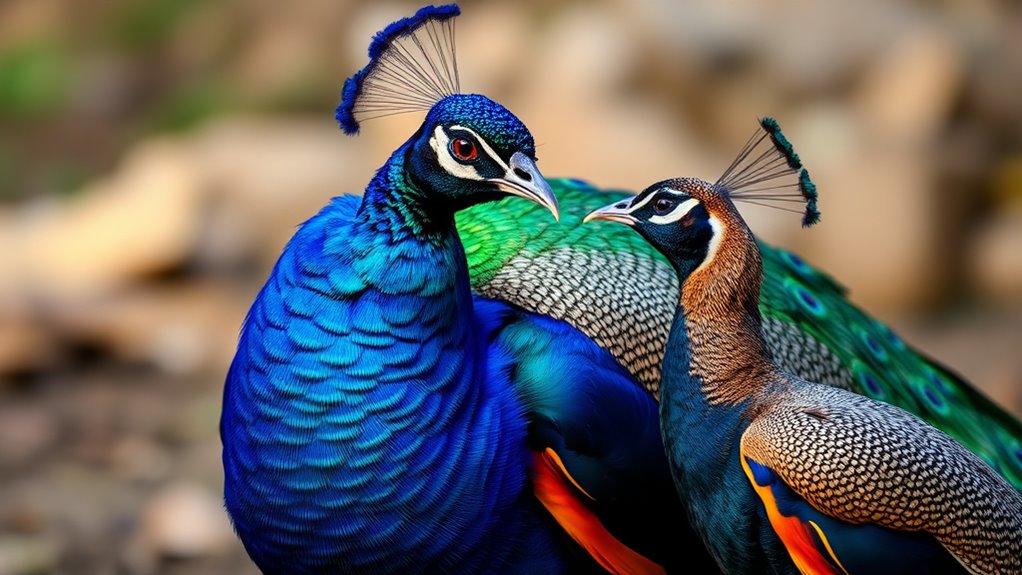
When you explore color vision in animals, you'll find that their ability to perceive different wavelengths greatly affects mating behaviors. This variation in color perception shapes how species select mates, as certain colors can signal health or genetic quality. Understanding these mechanisms helps you grasp the complexities of attraction in the animal kingdom. For instance, different organisms' reactions to specific areas of the visible spectrum can influence their mating preferences and behaviors.
Color Perception Mechanisms
Color perception mechanisms play an essential role in animal mating behaviors, greatly influencing how individuals attract mates and select partners. Different animals have evolved unique color vision systems that enhance their mating success.
Here are some key points to reflect on:
- Types of Vision: You might find animals with dichromatic, trichromatic, or even tetrachromatic vision, impacting their color detection.
- Opsin Genes: The variety in opsin genes helps animals perceive different light wavelengths, enhancing their visual capabilities.
- Neural Mechanisms: Wavelength opponency increases sensitivity to colors, making it easier for animals to identify potential mates. Increased sensitivity in color vision can lead to more effective mate attraction through vibrant displays.
- Innate Preferences: Many species have specific color preferences that guide their mating behaviors, ensuring they attract the right partners.
Understanding these mechanisms highlights the complex interplay between vision and attraction in the animal kingdom.
Influence on Mate Selection
While many factors influence mate selection in the animal kingdom, color vision stands out as a critical element that drives attraction and choice. Bright colors often signal a male's quality and territory, impacting female preferences.
Throughout evolution, color vision has developed, with sexual color signals emerging about 100 million years ago. Males frequently shift colors during courtship to attract females, who typically favor specific color patterns. Recent studies highlight the role of male colour change in female mate choice, demonstrating that vibrant displays can indicate fitness and attractiveness.
Environmental factors like diet can also affect coloration, further influencing mate choice. In species like sticklebacks, females prefer males with particular nuptial colors.
Ultimately, these vibrant displays serve as essential communication tools, showcasing health and genetic quality while playing a significant role in the complex dance of mating behaviors.
The Influence of Environmental Factors on Color Displays
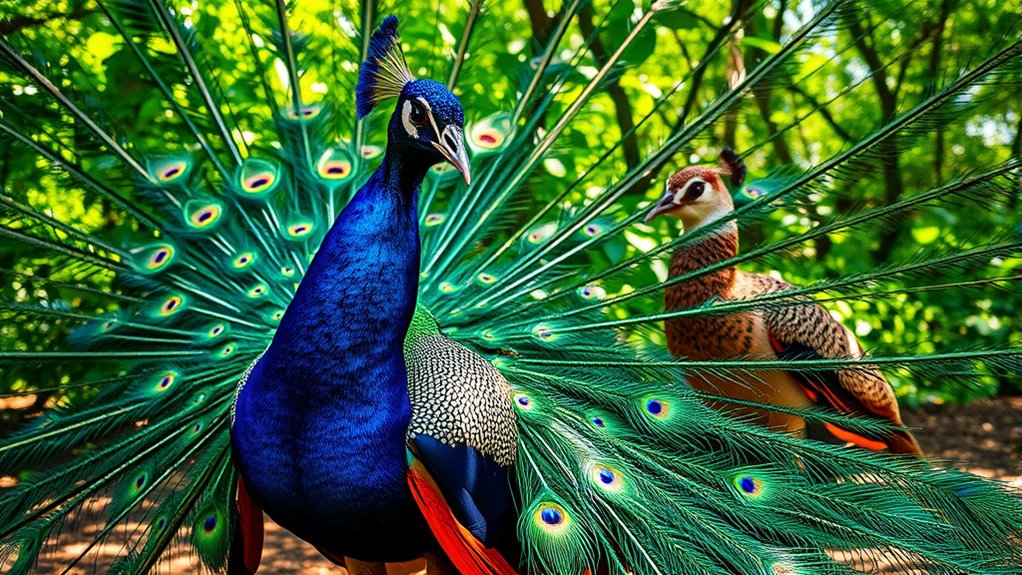
Environmental factors play an essential role in shaping color displays among various species, as they directly influence visibility and effectiveness during mating rituals. Understanding these influences can deepen your appreciation for nature's complexity.
Here are some key aspects to evaluate:
- Light Availability: Males, like guppies, adjust their courtship displays based on light intensity.
- Temperature and Climate: Saturation and brightness of colors change with varying temperatures, as seen in common lizards, which can affect male competition during mating seasons.
- Resource Availability: In emperor penguins, access to resources dictates when males can display during courtship.
- Habitat Structure: Colors often appear more vibrant in forested areas due to structural influences.
These factors collectively shape how animals communicate and attract mates, highlighting the dynamic interplay between environment and behavior.
Sexual Dichromatism and Its Implications for Mating

Sexual dichromatism, which refers to the striking differences in coloration between males and females, plays a pivotal role in animal mating strategies.
You'll notice this phenomenon across many species, like peacocks, chameleons, and frogs, where vibrant colors signal male fitness and attract females. Brightly colored males often have an advantage in mate selection, as these hues indicate health and genetic viability. In competitive environments, such colors can enhance a male's chances of mating, while also helping females identify suitable partners and avoid interspecies mating. Recent studies have shown that dynamic coloration during breeding can further influence reproductive success in amphibians, emphasizing the intricate relationship between coloration and mating strategies.
The genetic and developmental mechanisms behind this trait highlight its evolutionary significance, as sexual selection continuously shapes these conspicuous traits, ensuring that sexual dichromatism remains a powerful driver in the animal kingdom.
Future Research Directions in Animal Coloration and Mating

As researchers explore deeper into the intricate relationship between animal coloration and mating, several key future research directions emerge.
These areas are essential for understanding how color influences mating dynamics in various species:
- Quantitative Metrics: Develop large-scale metrics to assess color traits across different environments.
- Phenotypic Plasticity: Investigate how environmental factors shape color expression and its mating implications. Understanding how climate warming affects animal coloration will be crucial to this line of research.
- Anthropogenic Impacts: Examine how human-induced changes affect color perception and mating behaviors.
- Multimodal Signaling: Study the interactions between visual and auditory signals in enhancing mating success.
Frequently Asked Questions
Do Animals Use Color for Communication Beyond Mating?
Yes, animals definitely use color for communication beyond mating.
You'll notice that bright colors often signal danger, warning predators to stay away. Camouflage helps them blend into their surroundings, enhancing survival.
Colors also convey social status within groups, influencing interactions. Plus, some animals change color for thermoregulation, adapting to their environments.
How Does Color Perception Differ Among Various Animal Species?
Did you know that some birds can see up to four times as many colors as you can?
Color perception varies widely among animal species due to differences in opsins and cone receptors. For instance, trichromats like you can see a broad spectrum, while dichromats, like dogs, see fewer colors.
In contrast, tetrachromats, such as certain birds, can detect ultraviolet light, enhancing their visual experience beyond human capabilities.
Each species adapts its color vision to its environment.
Can Environmental Changes Affect the Color Displays of Animals?
Yes, environmental changes can greatly affect animal color displays.
You might notice that pollutants in their habitats alter the pigments they acquire through their diet. Habitat destruction can limit these sources, leading to muted colors.
Additionally, light pollution disrupts how animals perceive colors, while climate change can force adaptations that change their coloration.
These shifts can impact not only their survival but also their ability to communicate and thrive in their ecosystems.
What Role Does Age Play in Color Vibrancy During Mating?
Age plays an essential role in color vibrancy. As you observe various species, you'll notice that younger males often lack the vivid colors of their mature counterparts.
These bright colors typically develop as they reach sexual maturity, signaling their fitness to potential mates. Hormonal changes influence these color shifts, making them more vibrant during breeding seasons.
Are There Cultural Influences on Color Preferences in Animal Mating?
You might say that cultural influences on color preferences in animal mating are like whispers in a crowded room, shaping choices subtly yet powerfully.
Animals often pick up on the preferences of their peers, mimicking successful mates they observe. This social learning can create trends in color preference, leading to variations in mating success.
As these preferences pass through generations, they can greatly impact mating behaviors and even drive evolutionary changes over time.
Conclusion
In exploring the vibrant world of animal mating, you uncover how color plays a pivotal role in courtship and mate selection. It's fascinating to realize that the hues you see in nature aren't just for beauty; they're intricately tied to survival and reproduction. As environmental changes shape color displays, you might find yourself wondering how these connections influence not just animals, but the very fabric of life itself, weaving together a complex tapestry of evolution and attraction.
